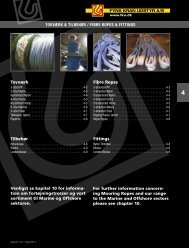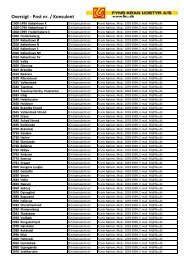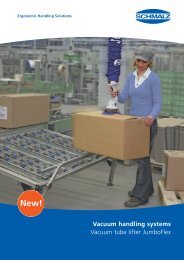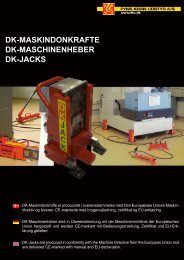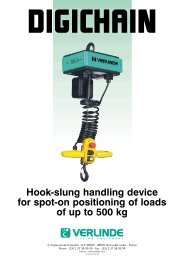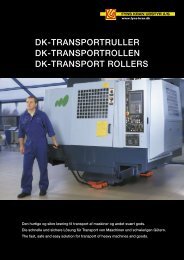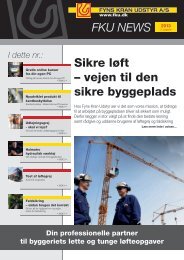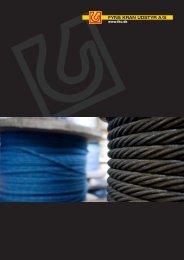Hent pdf-fil - Fyns Kran Udstyr A/S
Hent pdf-fil - Fyns Kran Udstyr A/S
Hent pdf-fil - Fyns Kran Udstyr A/S
Create successful ePaper yourself
Turn your PDF publications into a flip-book with our unique Google optimized e-Paper software.
www.fku.dk<br />
UDDANNELSE & TEKNISK INFORMATION / EDUCATION & TECHNICAL INFORMATION<br />
12-7<br />
Andre dugttyper<br />
Som tidligere nævnt, findes der også dugter, der er en<br />
kombination af én eller flere af ovenstående fire dugtgrundtyper.<br />
En af disse er Warrington Seale (Fig. 11). Denne konstruktion<br />
er opbygget som en Warrington med et lag mere og hører til en<br />
af de mest udbredte. Desuden er Warrington Seale den mest<br />
bøjelige konstruktion i sammenligning med de fire grundtyper.<br />
Warrington Seale konstruktionen er kendetegnet ved, at dugten<br />
består af tre trådlag fremstillet i én operation. Antallet af tråde<br />
i tredje lag (yderlag) svarer til antallet af tråde i andet lag.<br />
Betegnelsen for en Warrington Seale dugt med f.eks. 36 tråde<br />
er (1-7-7+7-14), dvs. 1 centertråd med 7 tråde i første lag, 14<br />
tråde fordelt på to tråddimensioner i andet lag og 14 tråde i<br />
tredje lag.<br />
Dugten samt dugtens tråde behøver ikke nødvendigvis at<br />
være runde. Eksempler på dette ses af Fig. 12. Dugterne er<br />
specialdugter (bl.a. med pro<strong>fil</strong>tråde) konstrueret til at opfylde<br />
helt specielle krav.<br />
Other Types of Strand<br />
As previously mentioned, there are also strands that are a<br />
combination of one or more of the above four basic types of<br />
strands. One of these is the Warrington-Seale (Fig. 11).<br />
This construction is one of the most widely-used and most<br />
flexible constructions compared to the four basic types.<br />
The Warrington-Seale construction is characterised by a strand<br />
consisting of three layers of wire produced in one operation. The<br />
number of wires in the third (outer) layer matches the number<br />
of wires in the second layer. Also, the layers below the outer<br />
layer are built as a Warrington construction. A Warrington-Seale<br />
strand with e.g. 36 wires is known as (14-7+7-7-1), i.e. one<br />
centre wire with seven wires in the first layer, 14 wires made<br />
up of two dimensions in the second layer and 14 wires in the<br />
third layer.<br />
The strands and the wires in the strands do not necessarily<br />
have to be round. Examples of this are shown in Fig. 12. The<br />
strands are special strands (i.a. with pro<strong>fil</strong>ed wires), designed to<br />
meet extremely unusual requirements.<br />
Fig. 11 Fig. 12<br />
Antal dugter<br />
Antallet af dugter i et ståltov varierer fra 3 til ca. 36, mest<br />
almindeligt er 6 dugter. Desto flere dugter et ståltov indeholder,<br />
desto rundere og mere fleksibelt bliver ståltovet (mindre<br />
slidstyrke).<br />
Hjertetype<br />
Som nævnt i afsnittet “Hjerte” findes der to typer hjerter til<br />
ståltove:<br />
- Fiberhjerte<br />
- Stålhjerte<br />
Fiberhjerte<br />
Fiberhjerte er det mest anvendte, da det udover at give dugterne<br />
et godt fjedrende underlag også muliggør smøring af ståltovet<br />
indefra, idet der under fremstillingen af fiberhjertet kan tilsættes<br />
olie og/eller fedt. Desuden reduceres risikoen for rustangreb<br />
indefra. Fiberhjertet fremstilles normalt af polypropylen (PP)<br />
eller sisal. PP kan modstå svage syrer og alkalier, og det rådner<br />
ikke. Fordelen ved et sisalhjerte er, at det i større grad kan<br />
optage olie/fedt for smøring af ståltovet indefra, og at ståltovet<br />
kan anvendes ved en højere temperatur i forhold til PP-hjerte.<br />
Number of Strands<br />
The number of strands in a steel wire rope varies between three<br />
and approx. 36, although most commonly there are six strands.<br />
The more strands a steel wire rope contains, the more rounded<br />
and flexible it is, although the wires in the strand are also<br />
thinner (less durable).<br />
Types of Cores<br />
As mentioned in the section: “Core”, there are two types of core<br />
for steel wire ropes:<br />
- Fibre core<br />
- Steel core<br />
Fibre Core<br />
Fibre cores are the most commonly used, as not only do they<br />
provide a good, elastic base but also enable lubrication of the<br />
rope from the inside, since it is possible to add oil and/or grease<br />
to the fibre core during production. This reduces the risk of rust<br />
attacking from the inside. The fibre core is normally produced<br />
from polypropylene (PP) or sisal. PP can withstand weaker acids<br />
and alkalis and it does not rot. The advantage of a sisal core is<br />
that it can absorb oil/grease to a greater degree for lubrication<br />
of the steel wire rope from the inside.<br />
Version 7.0 - Maj 2013<br />
Odense | Vallensbæk | Esbjerg | Aalborg<br />
+45 7015 2015 | fku@fku.dk<br />
12



